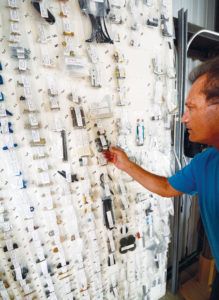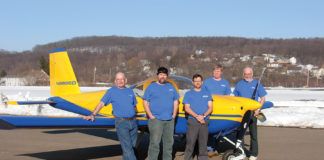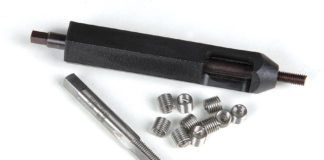Overheard comments are often the most interesting, probably because your brain is in a more receptive mode than if also occupied trying to one-up the person talking. In any case, last week I tapped into a brief diatribe on how the current bunch of amateurs building airplanes have had their hands held so long by super-complete plans, step-by-step instructions and half-built, all-inclusive kits, not to mention nearly on-demand help lines and flat-fee long-distance phone plans that, “They don’t know how to build an airplane anymore.”

My reptile-quick response was to agree, as such comments fit my natural tendency to consider anything newer than 1953 as rocket-propelled to perdition. That’s partially the result of depression-era parenting where straightening a can full of bent nails was best use of a Saturday morning and reinforced by an early employer who with noisy fanfare cursedly threw brand-new, non-functional, pressed-metal lamp sockets into the trash can and replaced them with pre-war porcelain sockets pulled from the junk pile. It didn’t hurt that the ancient light sockets worked just fine and the brand-new stamped junk didn’t.
But time devolves and where at least dad could once make a passable argument for straightening nails—“Do you want to eat dinner tonight?”—today manufacturing is cheap and labor is expensive. Which in itself is sort of funny as we have double the people on this planet as when I was a kid and you’d think they’d all need a job, but that’s perhaps a bit over the horizon even for this column. But the point is it’s now smarter to let machines spit out so many perfect little parts than to whittle out reasonable facsimiles by hand in the back of the woodshed.
And so back to whether or not moderns can put together a kit aircraft. Well, sure we can, otherwise there wouldn’t be a new RV flying every other day or whatever it is. That said, compared to where homebuilding started, there is a lot of hand-holding these days. If you consider the hobby began before WW-II, then sort of simmered through the 1950s before hitting its first big wave of plans building in the 1960s and ’70s, then it’s good to recall many people came off the farm back then. Living on the farm meant machinery was everyday wear for young people, and keeping that machinery running meant figuring out what made it run or not, using what you had on hand. Or if junior wasn’t a farm boy, he was close to, if not actually, a hot-rodder. Kids used to play with cars back when it was possible to make one run faster—or keep running—as the case may be. Toss in a couple fingers lost in high school shop class and by the time these folks were ready for an airplane, it wasn’t that big a step to roll out a set of plans and figure out where to start cutting wood and metal. Today’s suburban upbringing doesn’t prep anyone like that; even the model airplanes are preformed foam these days despite the dope smelling as good as ever and balsa wood in ready supply.
And just in case you missed the early plansbuilt experience, it was for the rugged individualist. My favorite example is the plans for the Starduster Too. Considered well-drawn, complete plans when they came out in the later 1960s, and still plenty good for putting together one of these fun biplanes, not only does the hand-holding stop firewall forward, the plans stop at the firewall altogether. The single photo on the box top suggests a Piper Comanche nose bowl has something to do with the cowling, but the only guidance on the plans on what to do for an engine, engine mount, cowling and propeller is a notation to the effect that “Starduster Corporation suggests only aircraft-grade hardware be used forward of the firewall.” And there was no forum to ask back then, either (there is now).
Even if you were the king of baling wire back in the day, we’ve all been staring into computer screens in an air-conditioned room for decades now. It’s largely true the old ways have atrophied as we’ve moved on to fast-build kits. And in a way, it had to. All of the Jetsons’ miracle labor-saving devices have turned into traffic jams, always-on email and posting photos of artistically coiffed salads to Instagram. Rake through a bin of fly-mart flotsam for whatever stack of AN hardware you think might work? No, today hardware better be bagged and tagged when it comes out of the box.
If building a kit aircraft today is more like an assembly line worker with a roving commission—“shoot these 10,000 rivets, then we’ll see about installing this pre-bent, pre-plumbed fuel system”—that doesn’t automatically mean we could not have done it the old way. In fact, there are some still building from plans. One place you can find them is on The Biplane Forum (www.biplaneforum.com). There’s all sorts of cutting, bending, welding and hole drilling going on there, not to mention rib stitching, doping, rigging, engine building and reading of plans. The old ways live.
But you’ll also find these craftsman digitizing, CNC cutting and printing parts, which underscores the truth that in many ways homebuilding isn’t dying, but changing. The tools are often different. The chemicals and glues, the methods of cutting and shaping, the range of materials readily available are all far better than when I was straightening nails. And one of the better things is the fast-build kit. Yeah, it’s a little like Revell versus Guillow’s, but the result is typically a better-built, more capable airplane.
As for the pilgrim calling Mayday on a forum because the plans don’t specify which bolt holds the ashtray or which rivet goes in such and such a hole, well, he’s correctly using the most powerful tool of all—the internet. There was a time when every one of us was a newbie and didn’t know that in some applications there’s really nothing critical about some fasteners. Any AN bolt that fits or rivet that shoots into a mushroom looking like all the others around it is going to be OK. But if you haven’t advanced that far yet, then you ask—and where better to ask than on a builder’s forum? Furthermore, you shouldn’t get barked at for doing so. What you should get is an education on the how and why of deciding what bolt can go in that hole.
One last thought. We’re building far more airplanes in this hobby than we ever did in the plansbuilt days. Therefore a far wider range of people are participating, and some of them weren’t born with a silver pencil stuck in the crook of their right ear. Or their dad made them straighten nails instead of showing them how to drive one. For them an all-inclusive, half-built kit is the perfect step away from the keyboard and into the shop. And that’s good for all of us.














For those wishing to practice scratch building skills without committing to building an entire plane that way, there is no harm in trying to recreate a part from your kit (pretend it was damaged and needed replacing), or make a part from a free or low cost set of plans (surely someone at the local EAA has a set of plans you can make a part from). If you screw it up, no worries, as it’s just for practice. But you can try out or practice scratch building skills just the same if people so desire.